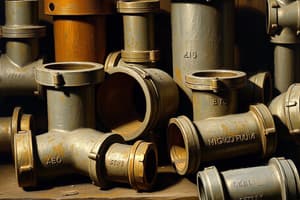Podcast
Questions and Answers
What is the function of pipe fittings?
What is the function of pipe fittings?
- To measure the internal diameter of the pipe
- To transport fluids between two points
- To join one section of pipe to another (correct)
- To determine the flow capacity of the pipe
Which material is suitable for high temperatures and pressures in pipes?
Which material is suitable for high temperatures and pressures in pipes?
- Copper
- PVC
- Polyethylene
- Steel (correct)
Which type of pipe is a cost-effective option for low pressure applications?
Which type of pipe is a cost-effective option for low pressure applications?
- PVC (correct)
- Cast iron
- Copper
- Steel
What does NPS stand for in the context of pipes?
What does NPS stand for in the context of pipes?
What determines the flow capacity of a pipe?
What determines the flow capacity of a pipe?
Which type of fitting is used to connect piping elements to fixtures?
Which type of fitting is used to connect piping elements to fixtures?
What is the purpose of a tee in piping?
What is the purpose of a tee in piping?
Why is it important to consider the strength and flexibility of piping materials during installation?
Why is it important to consider the strength and flexibility of piping materials during installation?
What role does a coupling play in a plumbing system?
What role does a coupling play in a plumbing system?
In what scenario would plastic piping be preferred over metal piping?
In what scenario would plastic piping be preferred over metal piping?
Why are proper maintenance and inspection procedures necessary for all types of plumbing systems?
Why are proper maintenance and inspection procedures necessary for all types of plumbing systems?
What function does an elbow serve in a plumbing system?
What function does an elbow serve in a plumbing system?
Study Notes
Pipes and Pipe Fittings
Pipes and pipe fittings play a crucial role in many industries where fluids need to be transported from one location to another. Understanding these components is essential for anyone who works with plumbing systems, HVAC equipment, or other fluid conveyance applications. Here's what you need to know about pipes and their associated fittings.
Pipes
A pipe refers to a tube used for conveying fluids such as water, gas, oil, chemicals, etc., between two points. Pipes come in various materials suitable for different purposes. Metal pipes, like copper, steel, and cast iron, can handle high temperatures and pressures while being resistant to corrosion. Plastic pipes like PVC or polyethylene are lightweight and less costly options for low pressure and temperature applications.
The inner diameter of the pipe determines its flow capacity, which directly correlates with the volume of liquid it can carry. Pipe size is typically measured by the nominal diameter, also known as NPS (nominal pipe size), which refers to the inside diameter of the pipe. For instance, a 2-inch pipe has an internal diameter of approximately 2 inches under typical conditions.
Pipe Fittings
Pipe fittings are designed to join one section of pipe to another or to connect piping elements to fixtures and valves. They come in various types, including elbows, tees, crosses, unions, and couplings, each serving specific functions.
For example, an elbow is a right-angled bend used when changing direction; a tee connects three sections of pipe at a single point; and a coupling joins two ends of pipe together without creating a junction. These components help adjust the flow direction, manage pressure changes, and create paths for liquids to travel through a system.
Installation Considerations
When installing pipes and fittings, several factors must be considered. Firstly, there needs to be a balance between the strength and flexibility of the material chosen. Secondly, the installation site matters – for example, it would be more challenging to run metal piping along walls compared to plastic piping due to the weight difference. Thirdly, the environment where the pipe will operate should be considered to ensure compatibility with the materials used.
It's important to note that proper maintenance and inspection procedures are necessary for all types of plumbing systems, regardless of the materials involved, to prevent leaks and prolong the life of the pipes and fittings.
Studying That Suits You
Use AI to generate personalized quizzes and flashcards to suit your learning preferences.
Description
Learn about the importance of pipes and pipe fittings in industries where fluid transportation is crucial. Discover the types of pipes, fittings, installation considerations, and maintenance procedures to ensure efficient fluid conveyance systems.




